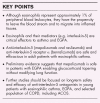Interleukin-5 pathway inhibition in the treatment of eosinophilic respiratory disorders: evidence and unmet needs
- PMID: 26859368
- PMCID: PMC4768650
- DOI: 10.1097/ACI.0000000000000251
Interleukin-5 pathway inhibition in the treatment of eosinophilic respiratory disorders: evidence and unmet needs
Abstract
Purpose of review: Human eosinophils were first identified and named by Paul Ehrlich in 1879 on the basis of the cell's granular uptake of eosin. Although eosinophils represent approximately 1% of peripheral blood leukocytes, they have the propensity to leave the blood stream and migrate into inflamed tissues. Eosinophils and their mediators are critical effectors to asthma and eosinophilic granulomatosis with polyangiitis (EGPA). Eosinophils are equipped with a large number of cell-surface receptors and produce specific cytokines and chemokines.
Recent findings: Eosinophils are the major source of interleukin-5 and highly express the interleukin-5Rα on their surface. Clinical trials evaluating monoclonal antibodies to interleukin-5 (mepolizumab and reslizumab) and its receptor interleukin-5Rα (benralizumab) have been or are underway in patients with eosinophilic asthma, EGPA and chronic obstructive pulmonary disease (COPD). Overall, targeting interleukin-5/interleukin-5Rα is associated with a marked decrease in blood and sputum eosinophilia, the number of exacerbations and improvement of some clinical parameters in adult patients with severe eosinophilic asthma. Pilot studies suggest that mepolizumab might be a glucocorticoid-sparing treatment in patients with EGPA. A preliminary study found that benralizumab did not reduce the exacerbations and did modify lung function in patients with eosinophilic COPD.
Summary: The review examines recent advances in the biology of eosinophils and how targeting the interleukin-5 pathway might offer benefit to some patients with severe asthma, EGPA, and COPD. Interleukin-5/interleukin-5Rα-targeted treatments offer promises to patients with eosinophilic respiratory disorders.
Figures





Similar articles
-
Anti-IL-5 therapies for chronic obstructive pulmonary disease.Cochrane Database Syst Rev. 2020 Dec 8;12(12):CD013432. doi: 10.1002/14651858.CD013432.pub2. Cochrane Database Syst Rev. 2020. PMID: 33295032 Free PMC article.
-
Immunological and hematological effects of IL-5(Rα)-targeted therapy: An overview.Allergy. 2018 Oct;73(10):1979-1988. doi: 10.1111/all.13451. Epub 2018 Oct 8. Allergy. 2018. PMID: 29611207 Free PMC article. Review.
-
The roles of IL-5 and anti-IL-5 treatment in eosinophilic diseases: Asthma, eosinophilic granulomatosis with polyangiitis, and eosinophilic chronic rhinosinusitis.Allergol Int. 2020 Apr;69(2):178-186. doi: 10.1016/j.alit.2020.02.002. Epub 2020 Mar 2. Allergol Int. 2020. PMID: 32139163 Review.
-
Monoclonal antibody therapy for the treatment of asthma and chronic obstructive pulmonary disease with eosinophilic inflammation.Pharmacol Ther. 2017 Jan;169:57-77. doi: 10.1016/j.pharmthera.2016.10.016. Epub 2016 Oct 20. Pharmacol Ther. 2017. PMID: 27773786 Review.
-
Rapid effect of benralizumab in exacerbation of severe eosinophilic asthma associated with eosinophilic granulomatosis with polyangiitis.BMC Pulm Med. 2021 Jan 21;21(1):35. doi: 10.1186/s12890-021-01397-7. BMC Pulm Med. 2021. PMID: 33478439 Free PMC article.
Cited by
-
Eosinophils in the pathogenesis of pancreatic disorders.Semin Immunopathol. 2021 Jun;43(3):411-422. doi: 10.1007/s00281-021-00853-0. Epub 2021 Mar 30. Semin Immunopathol. 2021. PMID: 33783592 Free PMC article. Review.
-
Presence of purpura is related to active inflammation in association with IL-5 in eosinophilic granulomatosis with polyangiitis.Rheumatol Int. 2021 Feb;41(2):449-454. doi: 10.1007/s00296-020-04672-8. Epub 2020 Aug 7. Rheumatol Int. 2021. PMID: 32770271 Free PMC article.
-
Mepolizumab in the management of severe eosinophilic asthma in adults: current evidence and practical experience.Ther Adv Respir Dis. 2017 Jan;11(1):40-45. doi: 10.1177/1753465816673303. Epub 2016 Nov 17. Ther Adv Respir Dis. 2017. PMID: 27856823 Free PMC article. Review.
-
Biologics and airway remodeling in severe asthma.Allergy. 2022 Dec;77(12):3538-3552. doi: 10.1111/all.15473. Epub 2022 Aug 23. Allergy. 2022. PMID: 35950646 Free PMC article. Review.
-
Benralizumab: From the Basic Mechanism of Action to the Potential Use in the Biological Therapy of Severe Eosinophilic Asthma.Biomed Res Int. 2018 May 10;2018:4839230. doi: 10.1155/2018/4839230. eCollection 2018. Biomed Res Int. 2018. PMID: 29862274 Free PMC article. Review.
References
-
- Ehrlich P. Beiträge zur Kenntnis der granulirten Bindegewbszellen und der ecosinophilen Leukocythen. Arch Anat Physiol (Leipzig) 1879; 3:166–169.
-
- Ehrlich P. Ueber die spezifischen granulationen des blutes. Arch Anat Physiol (Leipzig) 1879. 571–579.
-
- Broughton SE, Nero TL, Dhagat U, et al. The betac receptor family: structural insights and their functional implications. Cytokine 2015; 74:247–258. - PubMed
-
- Landolina N, Gangwar RS, Levi-Schaffer F. Mast cells’ integrated actions with eosinophils and fibroblasts in allergic inflammation: implications for therapy. Adv Immunol 2015; 125:41–85. - PubMed
Publication types
MeSH terms
Substances
LinkOut - more resources
Full Text Sources
Other Literature Sources
Medical
Research Materials

